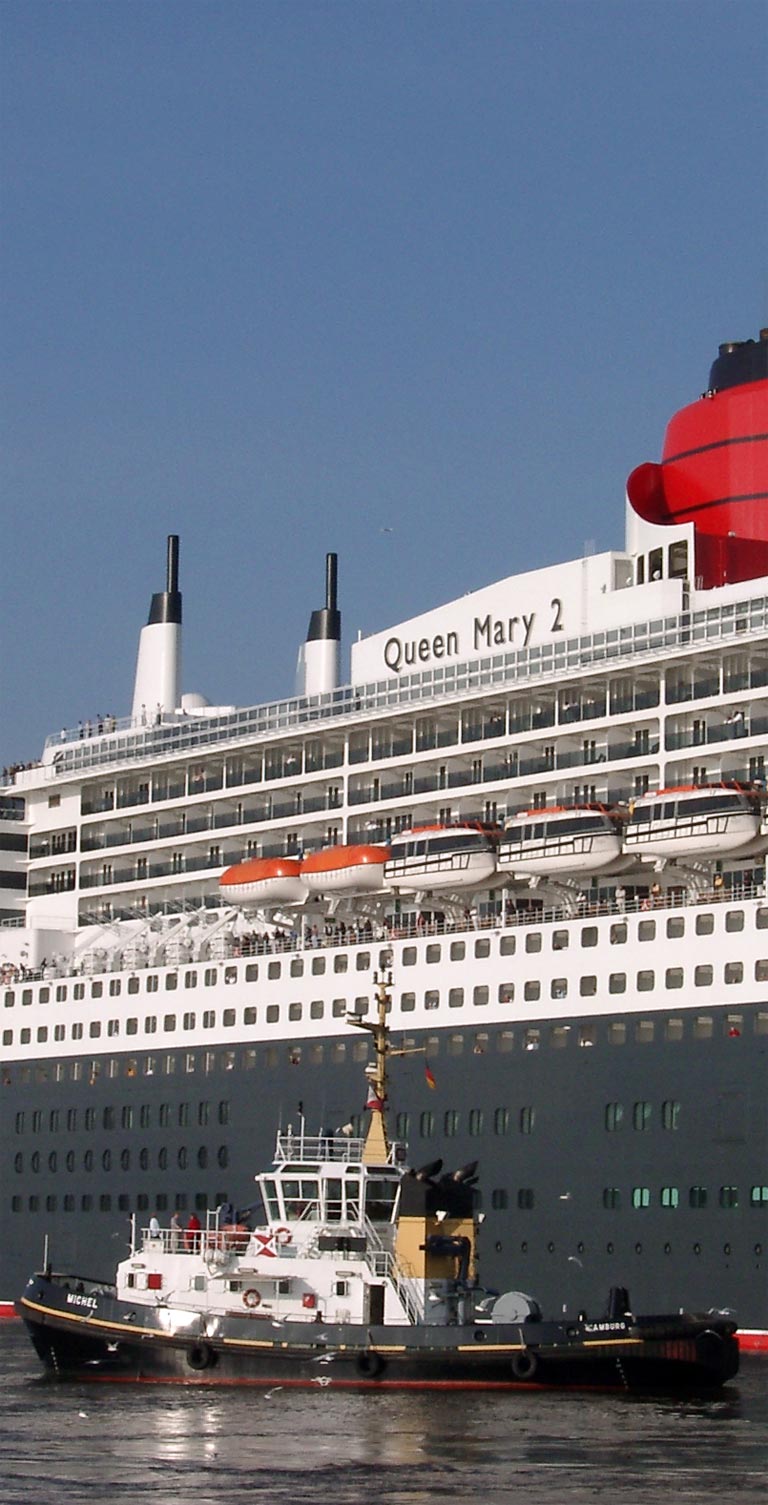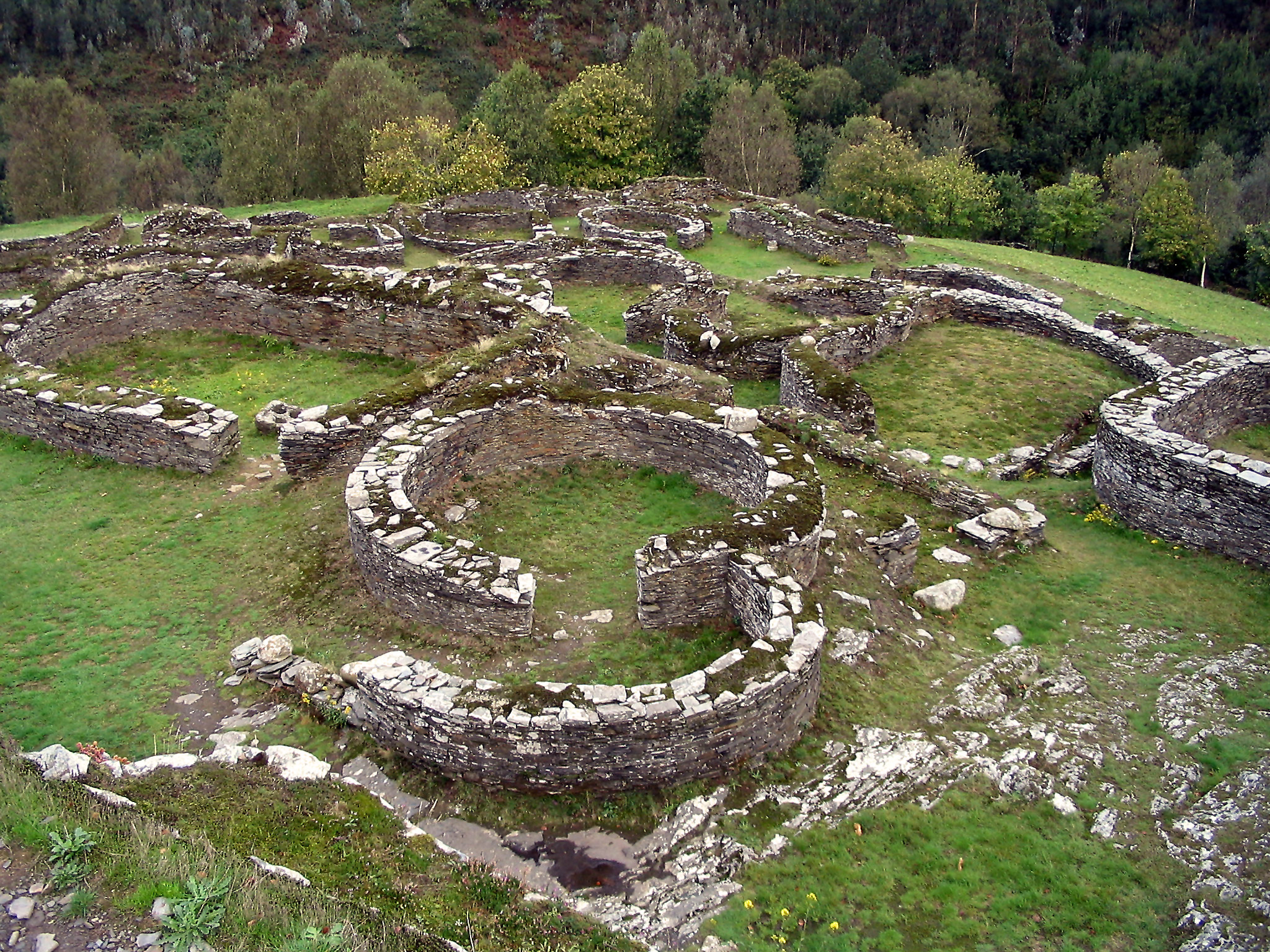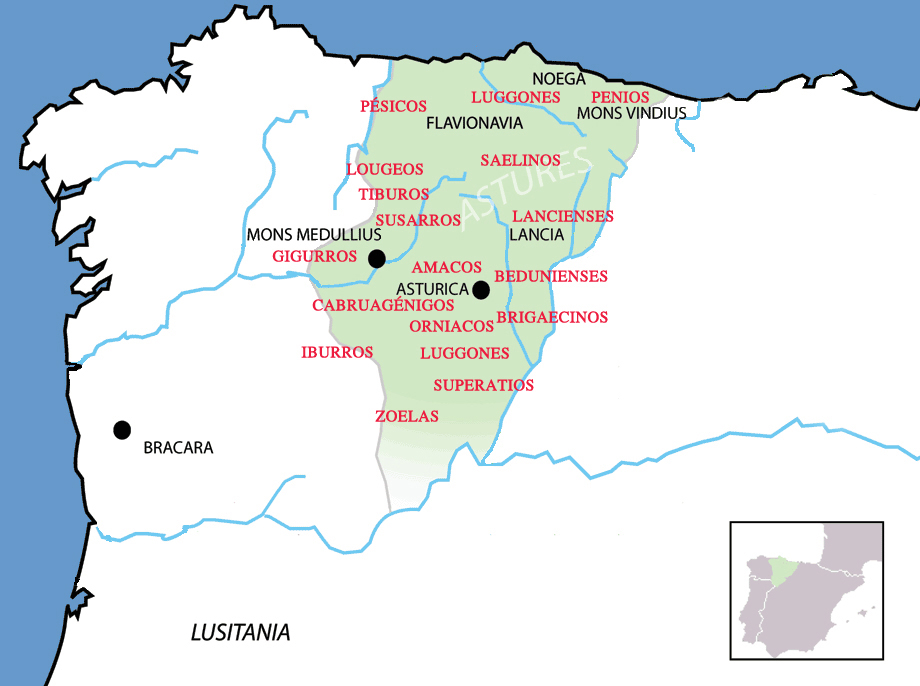|
Castle Lupario
The Castle Lupario, also known as the Castle Beca, is a Gallaeci castro located between the towns of , (Brión) and ( Rois). Background The site was declared an Asset of Cultural Interest in December 2009. It is easily accessible and remains of the walls can be seen. This caste complex was perhaps the capital of the (Astures) and came to achieve great importance. A parish church, Santo Antonini de Castro, existed on the site until the also existed here until the beginning of the 17th century. The Liber Sancti Jacobi places Queen Lupa's residence at this castle. Gallery File:Mapa da translaçom em Historia del Apostol de Iesus Christo Sanctiago Zebedeo (1610).jpg, Map of the legend of the translation of relics in ''Historia del Apostol de Iesus Christo Sanctiago Zebedeo'' (1610), by Mauro Castellá Ferrer, in which the Castle Lupario appears. See also * Castro * Castros in Galicia * Iron Age Europe * Castro culture Castro culture ( gl, cultura castrexa, pt, cultur ... [...More Info...] [...Related Items...] OR: [Wikipedia] [Google] [Baidu] |
Brión
Brión () is a municipality in the province of A Coruña, in the autonomous community of Galicia in northwestern Spain , image_flag = Bandera de España.svg , image_coat = Escudo de España (mazonado).svg , national_motto = '' Plus ultra'' ( Latin)(English: "Further Beyond") , national_anthem = (English: "Royal March") , .... It belongs to the comarca of Santiago de Compostela and is 13 km to the east of Santiago de Compostela. It has an area of , and a population of 7,519 inhabitants (2014). References [...More Info...] [...Related Items...] OR: [Wikipedia] [Google] [Baidu] |
Province Of A Coruña
The province of A Coruña (; es, La Coruña ; historical en, link=no, Corunna) is the northwesternmost province of Spain, and one of the four provinces which constitute the autonomous community of Galicia. This province is surrounded by the Atlantic Ocean to the west and north, Pontevedra Province to the south and Lugo Province to the east. History The history of this province starts at the end of the Middle Ages during the reign of the Catholic Monarchs of Spain. During those years this province was far smaller than today. This is because in the 1833 territorial division of Spain the entire Province of Betanzos together with half of the Mondoñedo were amalgamated into one single province with its capital city in A Coruña. Since 1833, the province has always been the one with the largest population and largest coast. Until the second half of the 20th century, this province was both the religious and cultural centre of the entire region. The University of Santiago ... [...More Info...] [...Related Items...] OR: [Wikipedia] [Google] [Baidu] |
Spain
, image_flag = Bandera de España.svg , image_coat = Escudo de España (mazonado).svg , national_motto = '' Plus ultra'' ( Latin)(English: "Further Beyond") , national_anthem = (English: "Royal March") , image_map = , map_caption = , image_map2 = , capital = Madrid , coordinates = , largest_city = Madrid , languages_type = Official language , languages = Spanish , ethnic_groups = , ethnic_groups_year = , ethnic_groups_ref = , religion = , religion_ref = , religion_year = 2020 , demonym = , government_type = Unitary parliamentary constitutional monarchy , leader_title1 = Monarch , leader_name1 = Felipe VI , leader_title2 = Prime Minister , leader_name2 = Pedro Sánchez , legislature = ... [...More Info...] [...Related Items...] OR: [Wikipedia] [Google] [Baidu] |
Gallaeci
The Gallaeci (also Callaeci or Callaici; grc, Καλλαϊκοί) were a Celtic tribal complex who inhabited Gallaecia, the north-western corner of Iberia, a region roughly corresponding to what is now the Norte Region in northern Portugal, and the Spanish regions of Galicia, western Asturias and western León before and during the Roman period. They spoke a Q-Celtic language related to Northeastern Hispano-Celtic, called Gallaecian or Northwestern Hispano-Celtic. The region was annexed by the Romans in the time of Caesar Augustus during the Cantabrian Wars, a war which initiated the assimilation of the Gallaeci into Latin culture. The endonym of modern-day Galicians, ''galegos'', derives directly from the name of this people. History The fact that the Gallaeci did not adopt writing until contact with the Romans constrains the study of their earlier history. However, early allusions to this people are present in ancient Greek and Latin authors prior to the conquest, ... [...More Info...] [...Related Items...] OR: [Wikipedia] [Google] [Baidu] |
Castros (Spain)
A castro is a fortified settlement, usually pre-Roman, some from late Bronze Age and Iron Age, the oldest research associated with the Celtic culture. These are frequently found in the Northern Spain, particularly in Asturias, Galicia, Cantabria, Basque Country and the province of Ávila, with the Castro culture and on the plateau with Las Cogotas culture. The word ''castro'' comes from the Latin ''castrum'', which means "hill fort". Castros of the Castro culture The castro is a fortified village that began to be inhabited from the 6th century BC, lacking streets of right angles and full of construction almost always circular. The oldest houses were mostly of straw-mud and the latest masonry. The roof was made of branches and mud and after long poles. Basically, they were unique rooms. These are located in naturally protected areas (heights, riots rivers, small peninsulas), close to water sources and arable land and on the border between these and higher areas of grazing. ... [...More Info...] [...Related Items...] OR: [Wikipedia] [Google] [Baidu] |
Rois, Spain
Rois is a municipality of northwestern Spain in the province of A Coruña in the autonomous community of Galicia Galicia may refer to: Geographic regions * Galicia (Spain), a region and autonomous community of northwestern Spain ** Gallaecia, a Roman province ** The post-Roman Kingdom of the Suebi, also called the Kingdom of Gallaecia ** The medieval King .... It belongs to the comarca of Sar and it is located in the Southwest of the province of A Coruña. References Municipalities in the Province of A Coruña {{galicia-geo-stub ... [...More Info...] [...Related Items...] OR: [Wikipedia] [Google] [Baidu] |
Bien De Interés Cultural
A Bien de Interés Cultural is a category of the heritage register in Spain. The term is also used in Venezuela and other Spanish-speaking countries. The term literally means a "good of cultural interest" (" goods" in the economic sense) and includes not only material heritage ( cultural property), like monuments or movable works of art, but also intangible cultural heritage, such as the Silbo Gomero language. Some ''bienes'' enjoy international protection as World Heritage Sites or Masterpieces of the Oral and Intangible Heritage of Humanity. History In Spain, the category of ''Bien de Interés Cultural'' dates from 1985 when it replaced the former heritage category of '' Monumento nacional ''(national monument) in order to extend protection to a wider range of cultural property. The category has been translated as "Cultural Interest Asset". ''Monumentos'' are now identified as one of the sub-categories of ''Bien de Interés Cultural.'' Sub-categories The movable heritag ... [...More Info...] [...Related Items...] OR: [Wikipedia] [Google] [Baidu] |
Astures
The Astures or Asturs, also named Astyrs, were the Hispano-Celtic inhabitants of the northwest area of Hispania that now comprises almost the entire modern autonomous community of Principality of Asturias, the modern province of León, and the northern part of the modern province of Zamora (all in Spain), and eastern Trás os Montes in Portugal. They were a horse-riding highland cattle-raising people who lived in circular huts of stone drywall construction. The Albiones were a major tribe from western Asturias. Isidore of Seville gave an etymology as coming from a ''river Asturia'', identified by David Magie with Órbigo river in the plain of León, by others the modern Esla river. Location The Asturian homeland encompassed the modern autonomous community of Asturias and the León, eastern Lugo, Orense, and northern Zamora provinces, along with the northeastern tip of the Portuguese region of Trás-os-Montes. Here they held the towns of ''Lancia'' (Villasabariego – L ... [...More Info...] [...Related Items...] OR: [Wikipedia] [Google] [Baidu] |
17th Century
The 17th century lasted from January 1, 1601 ( MDCI), to December 31, 1700 ( MDCC). It falls into the early modern period of Europe and in that continent (whose impact on the world was increasing) was characterized by the Baroque cultural movement, the latter part of the Spanish Golden Age, the Dutch Golden Age, the French '' Grand Siècle'' dominated by Louis XIV, the Scientific Revolution, the world's first public company and megacorporation known as the Dutch East India Company, and according to some historians, the General Crisis. From the mid-17th century, European politics were increasingly dominated by the Kingdom of France of Louis XIV, where royal power was solidified domestically in the civil war of the Fronde. The semi-feudal territorial French nobility was weakened and subjugated to the power of an absolute monarchy through the reinvention of the Palace of Versailles from a hunting lodge to a gilded prison, in which a greatly expanded royal court could be more easi ... [...More Info...] [...Related Items...] OR: [Wikipedia] [Google] [Baidu] |
Liber Sancti Jacobi
The (also ''Compostellus'') is the main witness for the 12th-century , or the Book of Saint James. It is a pseudepigraph attributed to Pope Callixtus II; its principal author or compilator is referred to as "Pseudo-Callixtus", often identified with French scholar Aymeric Picaud. Its most likely date of compilation is the period of 11381145.Purkis, William J. ''Crusading Spirituality in the Holy Land and Iberia, c.1095-c.1187'' (2014)p. 140 It was intended as an anthology of background detail and advice for pilgrims following the Way of St. James to the shrine of the apostle Saint James the Great, located in the cathedral of Santiago de Compostela, Galicia (Spain). The collection includes sermons, reports of miracles and liturgical texts associated with Saint James, and a set of polyphonic musical pieces. In it are also found descriptions of the route, works of art to be seen along the way, and the customs of the local people. History The compilation of ''Codex Calixtinus'' preda ... [...More Info...] [...Related Items...] OR: [Wikipedia] [Google] [Baidu] |
Queen Lupa
Queen Lupa (also known as Raíña Lupa, Raíña Lopa, Raíña Luparia, Raíña Luca and Raíña Loba) is a character from Galician mythology. She is mentioned in both the ''Codex Calixtinus'' and the ''Golden Legend'' involving the translation of the body of the Apostle James by his disciples. Her name alludes to her cunning, and she is written as being a roadblock to the disciples of the Apostle James, Theodore and Athanasius, as they search for a place to entomb his body. She eventually sees her error and converts to Christianity. Her story is well-known throughout Galicia and she still influences the culture of that portion of Spain. Her story is integral to the translation of the relics of the apostle, and her home is along the route of the Portuguese Way to Santiago de Compostela. Legend Galician mythology, Galician tradition holds that Lupa, a widowed noblewoman, lived in Castro Lupario, along what is now called the Portuguese Way. She appears in Book III (''Liber de tr ... [...More Info...] [...Related Items...] OR: [Wikipedia] [Google] [Baidu] |
Golden Legend
The ''Golden Legend'' (Latin: ''Legenda aurea'' or ''Legenda sanctorum'') is a collection of hagiographies by Jacobus de Voragine that was widely read in late medieval Europe. More than a thousand manuscripts of the text have survived.Hilary Maddocks, "Pictures for aristocrats: the manuscripts of the ''Légende dorée''", in Margaret M. Manion, Bernard James Muir, eds. ''Medieval texts and images: studies of manuscripts from the Middle Ages'' 1991:2; a study of the systemization of the Latin manuscripts of the ''Legenda aurea'' is B. Fleith, "Le classement des quelque 1000 manuscrits de la Legenda aurea latine en vue de l'éstablissement d'une histoire de la tradition" in Brenda Dunn-Lardeau, ed. ''Legenda Aurea: sept siècles de diffusion", 1986:19-24 It was likely compiled around the years 1259–1266, although the text was added to over the centuries. Initially entitled ''Legenda sanctorum'' (''Readings of the Saints''), it gained its popularity under the title by which ... [...More Info...] [...Related Items...] OR: [Wikipedia] [Google] [Baidu] |





_F0173k.jpg)
